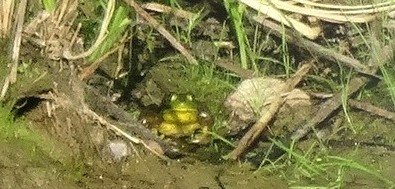9/08/2022
very green heron
9/07/2022
turtle tower
9/06/2022
vivipary = seed heads sprouting
This wildflower was finished blooming and was forming seeds. But its seed head sprouted green leaves! Fascinated, I looked closer. Some of new seeds were actually germinating and sprouting while still in the seed head. Usually, they wait until they are in the perfect place (soil, moisture, temperature, sunlight) to begin new growth. Sometimes you see this while seeds are still inside the fruit, like a tomato or green pepper. In plants, it is called vivipary (Latin for 'live birth') and involves seeds germinating before their determined time. I first learned about this a few years ago when my grandson sent me a photo of a sunflower seed head that was doing the same thing.
9/05/2022
scouring rush 'horsetail'
Scouring Rush Equisetum hyemale grows in the wetland around the pond.
It is also called 'horsetail'. This plant has coarse fibers and silica deposits in its stems, so herbivores don't eat this plant.
For more about this plant, see blog posts on 7/23/2020 and 6/25/2021.
9/04/2022
hummingbirds sitting still
Ruby-throated Hummingbirds have been enjoying the red trumpet flowers on the lonicera vine all summer. Finally, we saw them sitting still!
9/03/2022
baby snapping turtle
We found this baby Snapping Turtle on a street curb in the neighborhood. We relocated it to the wetland around the pond, hoping it would find enough to eat there. Snapping Turtles Chelydra serpentina eat water plants as well as insects, worms, snails, small fish, and anything edible that it can find.
8/28/2022
senna
8/19/2022
8/15/2022
August wildflowers
8/07/2022
8/02/2022
summer native bloomers
Blossoming among the grasses and rushes around the pond are Blue Vervain, Culvers Root, Wild Bergamot, Evening Primrose. Seed heads of Penstemon stand as they dry in the sun.
7/30/2022
green heron preening
7/27/2022
tiny toad
On a patch of gravel a toad, the size of a quarter coin, was hunting for breakfast among the spider webs.
7/23/2022
young blackbird showing epaulets
This young male Red-winged Blackbird was begging his mom to give him food from the seed feeder. I can tell he is a male because he's already starting to get his bright colored 'epaulets' on his shoulders. She has been putting food in his mouth whenever he gapes since he hatched out of his egg. But now that she is hoping he will find his own food!
7/22/2022
vervain
7/16/2022
turtle chases ducks off favorite rock
7/15/2022
monardas - bee balm - bergamot
7/10/2022
green frog looks like . . .
7/08/2022
7/07/2022
culver's root
7/05/2022
7/04/2022
7/03/2022
mallard families
Female Mallard came out of the grasses with her 3 young ducks (upper right). Then, another Mallard appeared with her 8 younger ducklings. They were all intent on eating duckweed and other aquatic plants growing in the pond.































